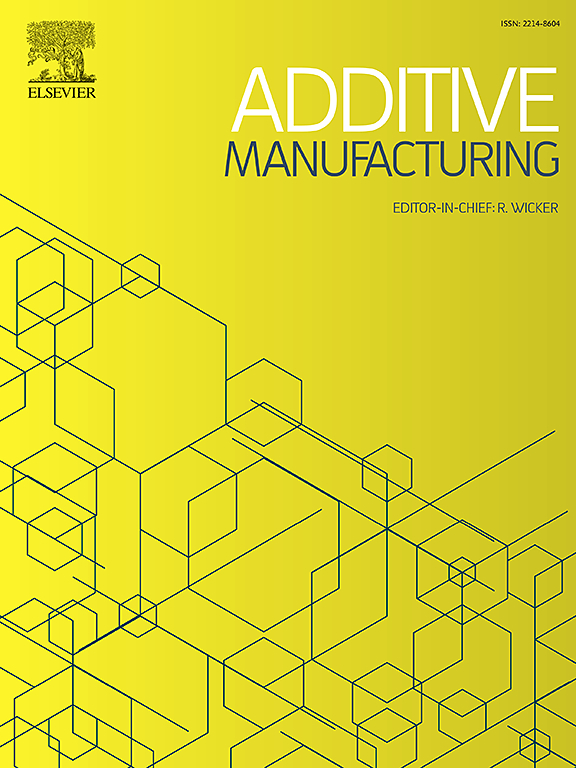Understanding residual stress in functionally graded directed energy deposition
IF 10.3
1区 工程技术
Q1 ENGINEERING, MANUFACTURING
引用次数: 0
Abstract
Residual stress within functionally graded material (FGM) fabricated by directed energy deposition (DED) limits their industrial application. This paper presents a new model for predicting residual stress in the DED-built FGM thin-wall structures, accommodating any DED process configurations or material combinations. To validate this model, SS316/IN718 FGM thin-wall structures were produced by powder-fed laser DED processes, and residual stresses along the longitudinal direction were measured by X-ray diffraction techniques. Under the same deposition parameters, five material composition transition paths from SS316 to IN718 were employed to quantify the effect of material mixing properties on the residual stress distribution. One path was based on the designed weight percentages of SS316 and IN718 in each deposition layer, while the other four paths were determined by detecting the average weight ratios of four elements: iron (Fe), nickel (Ni), niobium (Nb) and titanium (Ti). The predicted residual stress profiles agreed with the measurements, with the maximum normalized root mean squared error (NRMSE) of 26.42 % observed in Nb-based predictions. The validated model was further extended to investigate residual stress distribution in two types of FGM thin-wall structures featured by tilted material transition regions: vertical- and horizontal-dominant walls. Results suggest that maximum tensile residual stresses are proportionally related to the material gradient angle (θ1) in vertical-dominant walls, while increasing the material gradient angle (θ2) in horizontal-dominant walls results in more compressive residual stresses at the FGM’s top surface. Based on a comprehensive understanding of the process mechanism using this practical model, it is now possible to propose novel deposition strategies that allow the material specification to be met while offering a reduced residual stress solution.
了解功能梯度定向能沉积中的残余应力
定向能沉积(DED)制备的功能梯度材料(FGM)内部的残余应力限制了其工业应用。本文提出了一种新的模型,用于预测DED制造的FGM薄壁结构的残余应力,该模型适用于任何DED工艺配置或材料组合。为了验证该模型,采用粉末喂料激光DED工艺制备了SS316/IN718 FGM薄壁结构,并利用x射线衍射技术测量了其纵向残余应力。在相同的沉积参数下,采用从SS316到IN718的5条材料成分转变路径来量化材料混合性能对残余应力分布的影响。一条路径是基于SS316和IN718在每个沉积层中的设计重量百分比,而其他四条路径是通过检测铁(Fe)、镍(Ni)、铌(Nb)和钛(Ti)四种元素的平均重量比来确定的。预测的残余应力分布与测量结果一致,基于铌的预测的最大归一化均方根误差(NRMSE)为26.42 %。进一步扩展了验证模型,研究了两种具有倾斜材料过渡区的FGM薄壁结构的残余应力分布:垂直和水平主导壁。结果表明,垂直优势壁面的最大拉伸残余应力与材料梯度角θ1成正比,而水平优势壁面的材料梯度角θ2越大,FGM顶面残余压应力越大。基于对使用该实用模型的过程机制的全面理解,现在可以提出新的沉积策略,使材料规格得到满足,同时提供减少残余应力的解决方案。
本文章由计算机程序翻译,如有差异,请以英文原文为准。
求助全文
约1分钟内获得全文
求助全文
来源期刊

Additive manufacturing
Materials Science-General Materials Science
CiteScore
19.80
自引率
12.70%
发文量
648
审稿时长
35 days
期刊介绍:
Additive Manufacturing stands as a peer-reviewed journal dedicated to delivering high-quality research papers and reviews in the field of additive manufacturing, serving both academia and industry leaders. The journal's objective is to recognize the innovative essence of additive manufacturing and its diverse applications, providing a comprehensive overview of current developments and future prospects.
The transformative potential of additive manufacturing technologies in product design and manufacturing is poised to disrupt traditional approaches. In response to this paradigm shift, a distinctive and comprehensive publication outlet was essential. Additive Manufacturing fulfills this need, offering a platform for engineers, materials scientists, and practitioners across academia and various industries to document and share innovations in these evolving technologies.
 求助内容:
求助内容: 应助结果提醒方式:
应助结果提醒方式:


